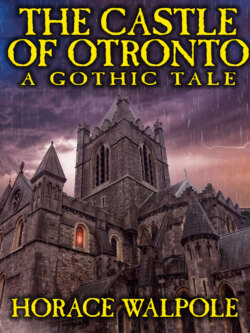Читать книгу The Castle of Otranto - Horace Walpole - Страница 4
На сайте Литреса книга снята с продажи.
INTRODUCTION
ОглавлениеHORACE WALPOLE, the fourth son of Sir Robert Walpole, was born at 17 Arlington Street on 24 September, 1717. He spent the greater part of his boyhood at his father’s house in Chelsea, a building that is now part of the Hospital.
At Eton, Walpole did not distinguish himself in any way. After leaving Cambridge in 1737, his father appointed him Inspector of Imports and Exports in the Customs House, and, in the following year, Usher to the Exchequer. In 1739 he began the usual “grand tour” on the Continent, where he developed a passion for antiquities.
He returned to England at the end of 1741. His father died in March 1745, and in 1747 Walpole settled in the neighbourhood of Twickenham at Strawberry Hill. The transforming of this house into “a little Gothic castle” and museum was the chief occupation of the greater part of his life. Here he erected a private printing press on which he printed many of his own works as well as some poems of Gray.
Although never really interested in politics, in 1754 Walpole entered Parliament as member for Castle Rising in Norfolk, vacating this seat three years later for that of Lynn. About this time, too, he made an unsuccessful attempt to save the unfortunate Admiral Byng.
He went to Paris in 1765, where he formed a friendship with Madame du Deffand which lasted until her death in 1780. But from 1769 until his death, his life, apart from intermittent literary work and adding to his museum, was comparatively uneventful. In 1773, however, his comedy Nature Will Prevail was acted at the Haymarket with considerable success.
In 1791, on the death of his brother, he acceded to the Earldom of Orford. He died at what was then 40 Berkeley Square on 2 March, 1797.
The Castle of Otranto was first published in 1764 and generally regarded as the first gothic novel. The initial edition was titled in full: The Castle of Otranto, A Story. Translated by William Marshal, Gent. From the Original Italian of Onuphrio Muralto, Canon of the Church of St. Nicholas at Otranto. This first edition purported to be a translation based on a manuscript printed at Naples in 1529 and recently rediscovered in the library of “an ancient Catholic family in the north of England.” This “ancient Catholic family” is possibly the Percy family, as Walpole would have known the Duke of Northumberland and his wife Elizabeth Percy, though this is not proven. He employed an archaic style of writing to further reinforce this.
The Italian manuscript’s story, it was claimed, derived from a story still older, dating back perhaps as far as the Crusades. This Italian manuscript, along with alleged author “Onuphrio Muralto,” were entirely fictitious; Walpole created them, and titular author “William Marshal” was his pseudonym.
In the second edition, Walpole applied the word “Gothic” to the novel in the subtitle—“A Gothic Story.” The novel merged medievalism and terror in a style that has endured ever since. The aesthetic of the book has shaped modern-day gothic books, films, art, music, and even the goth subculture.
The novel initiated a literary genre which would become extremely popular in the later 18th and early 19th century, with authors such as Clara Reeve, Ann Radcliffe, William Thomas Beckford, Matthew Lewis, Mary Shelley, Bram Stoker, Edgar Allan Poe, Robert Louis Stevenson, and George du Maurier (among many, many others).
—Karl Wurf
Rockveille, MD
